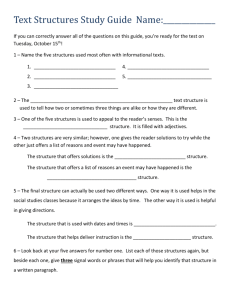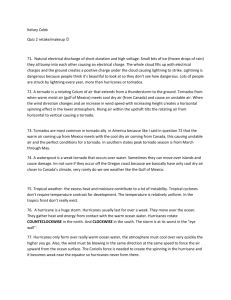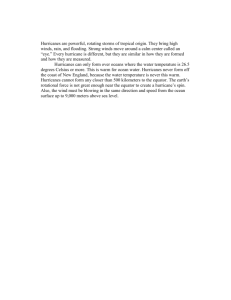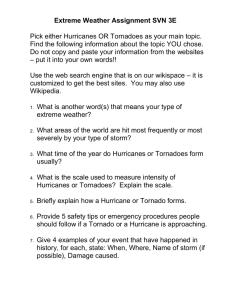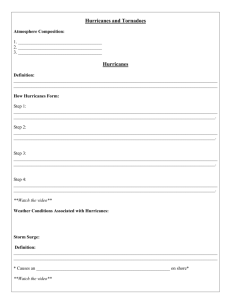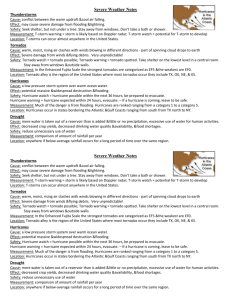File - Melanie Smith's Virtual Portfolio
advertisement
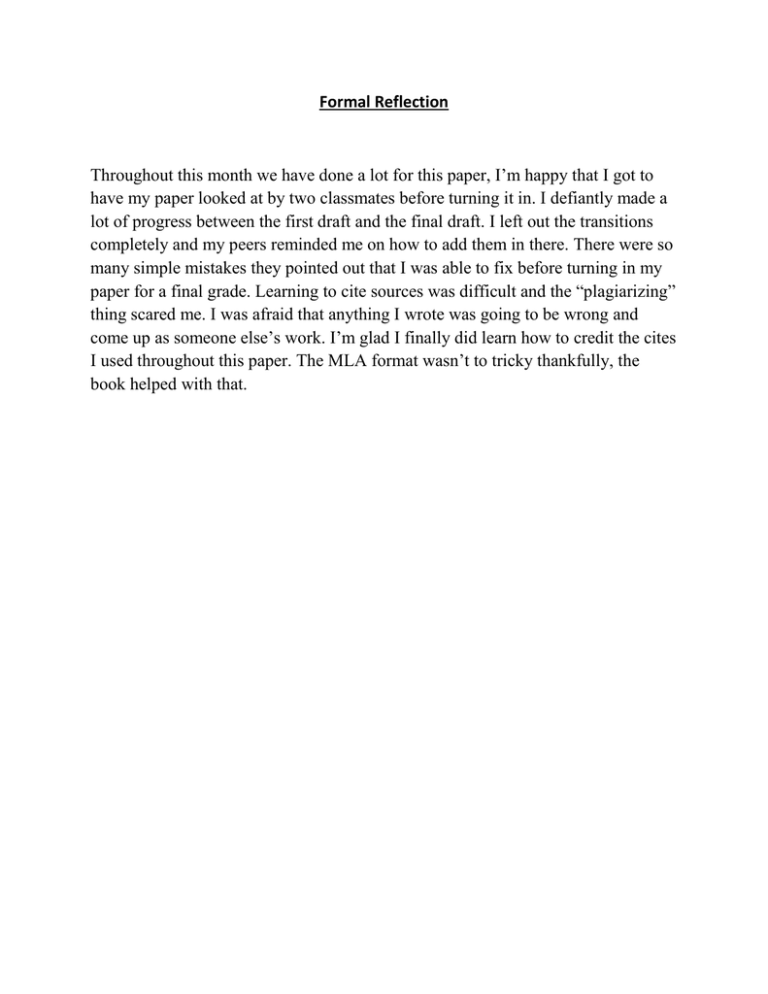
Formal Reflection Throughout this month we have done a lot for this paper, I’m happy that I got to have my paper looked at by two classmates before turning it in. I defiantly made a lot of progress between the first draft and the final draft. I left out the transitions completely and my peers reminded me on how to add them in there. There were so many simple mistakes they pointed out that I was able to fix before turning in my paper for a final grade. Learning to cite sources was difficult and the “plagiarizing” thing scared me. I was afraid that anything I wrote was going to be wrong and come up as someone else’s work. I’m glad I finally did learn how to credit the cites I used throughout this paper. The MLA format wasn’t to tricky thankfully, the book helped with that. Self-Reflection Rubrics Introduction Rubric Student Name: __Melanie Smith____ 4 3 Hook Hook captivates the audience and makes them want to know more. A hook was Hook was attempted Hook is missing attempted and but the reader is not and/or reader is not somewhat captivates engaged. engaged. the reader’s attention. Length Paragraph meets the Paragraph is missing length requirement. 1 sentence in order to meet length requirement. Paragraph is missing multiple sentences in order to meet the length requirement. Thesis Statement Thesis statement is easily identifiable and contains all the qualities of a good thesis. The location of the thesis is also correct. The thesis is identifiable but the statement does not contain all the elements of a strong thesis statement. The location of the thesis is correct. The thesis statement The thesis statement is lacking in areas is not included in the and/or is in the intro. paragraph. wrong location. Progress Substantial effort and progress has been made through the creation of the map, first draft, and now the second draft of the intro. Progress had been made through the creation of the map, first draft, and now the second draft of the intro. Little progress has been made through the creation of the map, first draft, and now the second draft of the intro. CATEGORY 2 1 Paragraph is not developed and does not meet the length requirement. No progress has been made through the creation of the map, first draft, and now the second draft of the intro. Body Paragraphs Rubric 3 2 1 0 Transitions are easily identifiable at the beginning of each paragraph and also are used correctly within the paragraphs to take the reader from one idea to the next. Transitions are identifiable and are used within the paragraphs to take the reader from one idea to the next. Transitions are only used at the beginning of paragraphs. No transitions were stated. The topic sentence clearly informs the informs the reader of reader of the subject the subject of the of the body body paragraphs. paragraphs. The topic sentence does not directly link to the main idea of the body paragraph. The topic sentence does not inform the reader of what they should expect to see in the body paragraph. Supporting Sentences The sentences clearly support the topic sentences and there is enough details included to meet length requirement. The sentences supports the topic sentences and there is enough details included to meet length requirement. The sentences are not easily readable and do not support the topic sentence; in turn, does not meet the length requirement. Missing supportive sentences. Wrap-up The paragraph has a sense of conclusion about it with the last sentence tying the reader back to the topic sentence. The paragraph is complete but needs to be tied back to the topic sentence a little more clearly. The paragraph The body paragraph needs more wrap-up is stopped abruptly. so that the reader is reminded of the topic sentence and main idea stated within the paragraph. CATEGORY Transitions Topic Sentence The topic sentence Aligned with Thesis Statement The paragraphs is directly aligned with the thesis statement Conventions The paragraphs are free of most grammar mistakes such as cap., end marks, and spelling. The paragraphs is not aligned with the thesis statement. The paragraphs are have few grammar mistakes such as cap., end marks, and spelling, but are still comprehendible. The paragraphs are difficult to understand due to grammar mistakes such as cap., end marks, and spelling. The paragraphs are not comprehendible due to grammar mistakes. Conclusion Paragraph CATEGORY 3 2 1 0 Transition The transition into the paragraph are easily identifiable at the beginning of paragraph and also are used correctly within the paragraphs to take the reader from one idea to the next. Transitions are identifiable and are used within the paragraphs to take the reader from one idea to the next. Transitions are only used at the beginning of the paragraph. No transitions were stated. Topic Sentence The topic sentence clearly informs the reader of the subject of the body paragraphs. The topic sentence informs the reader of the subject of the body paragraphs. The topic sentence does not directly link to the main idea of the body paragraph. The topic sentence does not inform the reader of what they should expect to see in the body paragraph. Supporting Sentences The sentences clearly support the topic sentences and there is enough details included to meet length requirement. The sentences support the topic sentences and there are enough details included to meet length requirement. The sentences are Missing supportive not easily readable sentences. and do not support the topic sentence; in turn, does not meet the length requirement. Impact The paragraph has a sense of conclusion about it leaving the readers strongly impacted and/or influenced. Restates the Thesis Statement Yes The paragraph has a sense of conclusion about it leaving the readers slightly impacted and/or influenced The paragraph The body paragraph needs more wrap-up is stopped abruptly. so that the readers are reminded of the original purpose. The paragraph is lacking a sense of closure. NO Final Draft Melanie Smith Mrs. Love English 11/10/12 Destructive Storms We can prepare for almost anything in this world and predict the outcome, but with natural disasters the outcome is unpredictable. This year 1,035 tornados and 11 hurricanes were recorded, most occurring in the United States (Tornados of 2012). Although hurricanes and tornados are destructive forces of nature, they both require intricate weather conditions that help create and develop the storm. Natural disasters are things we cannot control that have horrible outcomes. These terrible storms leave society devastated with damaged homes and take the lives of many they come in contact with. Whether it’s a tornado spinning out of control or a hurricane washing everything away, these storms have many of the same as well as many different characteristics. Basically, Tornados are fiercely spinning columns of air that are in contact with the surface of the earth (Tornado). These storms come in many shapes and sizes, and have a wide range of colors just like hurricanes; but tornados look like a twisty funnel spinning all around. The wind speed of most tornados is less than 110 miles per hour and they can travel up to a couple miles (Tornado). Tornados are very violent and tear up everything in the way. The most extreme recorded tornado acquired wind speeds of more than 300 miles per hour, stretched more than two miles long, and stayed on the ground for dozens of miles (Tornado). Tornados are most frequent in between the Rocky Mountains and Appalachian Mountains. Texas, Kansas, and Oklahoma report the most tornados out of any states in the United States. In states like these, they have strict laws for building of homes. Houses are required to have strengthened roofs and secure building foundations (Tornado Alley). On the other hand, Hurricanes are types of tropical storms that form in the southern Atlantic Ocean, Gulf of Mexico, Caribbean Sea, and the Eastern Pacific Ocean. While tornados form on land, hurricanes form over a body of water and can create heavy rain and flooding. Just like tornados, hurricanes create winds up to 155 miles per hour. When hurricanes approach the mountains, they produce heavy rainfall and can trigger mudslides or landslides which are very dangerous (Hurricanes). There are many different types of tornados, just like hurricanes, but they all lead to the same destruction. Sometimes hurricanes can spiral into tornados, this happens during an extremely intense hurricane (Damage & Effects). Hurricanes can occur for a few days, or even weeks, when tornados happen over a few minutes. Tornados are scaled based on the Fujita Scale, which determined how bad the tornado is according to the path length, width, and wind speed. A F0 tornado has wind speeds up to 72 mph, and the path width is up to 50. The damage a F0 tornado leaves behind are pretty mild; branches broken off trees, chimney damage and light damage. A more serious tornado may be called A F5 tornado, which has wind speed of up to 512mph. This type of tornado leaves behind major damage such as: houses lifted off foundations, cars flying through the air, concrete structures badly broken and damaged (Fujita Scale). Unlike tornados hurricanes are strictly based on a wind scale according to how bad the wind is. Sustained winds up to 95mph are categorized as a one. A category one hurricane can damage gutters, roofs and shingles: Branches will also fall and snap onto power lines, which can cause power outages that last up to several days. A category five hurricane has wind speeds of 157mph and higher, this is the worst kind of hurricane and is marked as major. Almost all homes are destroyed, these storms leave homes with no roofs and total wall collapse, as well as power lines crushed by trees causing power outages that can last for weeks or even months (Saffier-Simpson). The government wants people to be prepared for any storm, the more prepared the better chance of survival one will have. When preparing for a hurricane people must know their surroundings; know if the house is flood-prone and know the elevation level. Know where the higher ground is in the community, locate all dams and lakes in the area and know whether they are a threat. All windows must be covered during hurricanes as well as tornados; the glass can shatter and break making a mess inside homes. Make sure trees around the house are trimmed down so the wind won’t knock them down (Hurricanes). The family should consider preparing a safe room with any storm. Beginning with tornados, one should have a firm plan and an emergency kit just like dealing with hurricane. For tornados, one will be safest in a cellar or basement (Tornados). Preparing for a natural disaster is very important and could sometimes mean life or death. Although both storms are different preparing for each is basically the same. Although these two deadly storms surprisingly have very little in common, they both have a damaging path that breaks almost everything along the way. The death rate has gone down over the years, but hurricanes and tornados take the lives of many today. The protocol for both requires being prepared. If one is not prepared for these types of storms then there is no way to be protected. These natural disasters have horrible outcomes leaving behind no power, broken homes, and hurt people. These destructive forces of nature both have different conditions that help create and develop the storm. It’s like looking at two different pictures and trying to find the differences, tornados and hurricanes are these terrible storms that create the same outcome but there are some differences along the way. Works Cited "Tornadoes of 2012." Wikipedia. Wikimedia Foundation, 11 Apr. 2012. Web. 07 Nov. 2012. <http://en.wikipedia.org/wiki/Tornadoes_of_2012>. "2012 Atlantic Hurricane Season." Wikipedia. Wikimedia Foundation, 11 July 2012. Web. 07 Nov. 2012. <http://en.wikipedia.org/wiki/2012_Atlantic_hurricane_season>. "Tornado." Wikipedia. Wikimedia Foundation, 11 July 2012. Web. 07 Nov. 2012. <http://en.wikipedia.org/wiki/Tornado>. "Tornado Alley." Wikipedia. Wikimedia Foundation, 11 July 2012. Web. 07 Nov. 2012. <http://en.wikipedia.org/wiki/Tornado_Alley>. "Hurricanes." Home. N.p., n.d. Web. 07 Nov. 2012. <http://www.ready.gov/hurricanes>. "Saffir-Simpson Hurricane Wind Scale." Saffir-Simpson Hurricane Wind Scale. N.p., n.d. Web. 13 Nov. 2012. <http://www.nhc.noaa.gov/aboutsshws.php>. "Fujita Scale." Wikipedia. Wikimedia Foundation, 11 Dec. 2012. Web. 13 Nov. 2012. <http://en.wikipedia.org/wiki/Fujita_scale>. "Tornadoes." Home. N.p., n.d. Web. 13 Nov. 2012. <http://www.ready.gov/tornadoes>. 2nd Draft Melanie Smith Mrs. Love English 11/10/12 Destructive Storms This year 1,035 tornados and 11 hurricanes were recorded, most occurring in the United States (Tornados of 2012). Although hurricanes and tornados are destructive forces of nature, they both require intricate weather conditions that help create and develop the storm. Natural disasters are things we cannot control that have horrible outcomes. These terrible storms leave society devastated without homes, or damaged homes, and they take the lives of many loved ones. Whether it’s a tornado spinning out of control or a hurricane washing everything away, these storms have many of the same as well as many different characteristics. Basically, Tornados are fiercely spinning columns of air that are in contact with the surface of the earth (Tornado). These storms come in many shapes and sizes, and have a wide range of colors just like hurricanes; but tornados look like a twisty funnel spinning all around. The wind speed of most tornados is less than 110 miles per hour and they can travel up to a couple miles (Tornado). Tornados are very violent and tear up everything in the way. The most extreme recorded tornado acquired wind speeds of more than 300 miles per hour, stretched more than two miles long, and stayed on the ground for dozens of miles (Tornado). Tornados are most frequent in between the Rocky Mountains and Appalachian Mountains. Texas, Kansas, and Oklahoma report the most tornados out of any states in the United States. In states like these, they have strict laws for building of homes. Houses are required to have strengthened roofs and secure building foundations (Tornado Alley). Hurricanes are types of tropical storms that form in the southern Atlantic Ocean, Gulf of Mexico, Caribbean Sea, and the Eastern Pacific Ocean. While tornados form on land, hurricanes form over a body of water. Hurricanes create heavy rain and flooding. Just like tornados, hurricanes create winds up to 155 miles per hour. When hurricanes approach the mountains, they produce heavy rainfall and can trigger mudslides or landslides which are very dangerous (Hurricanes). There are many different types of tornados, just like hurricanes, but they all lead to the same destruction. Sometimes hurricanes can spiral into tornados, this happens during an extremely intense hurricane (Damage & Effects). Hurricanes can occur for a few days, or even weeks, when tornados happen over a few minutes. Tornados are scaled based on the Fujita Scale, which determined how bad the hurricane is according to the path length, width, and wind speed. A F0 tornado has wind speeds up to 72 mph, and the path width is up to 50. The damage a F0 tornado leaves behind are pretty mild; branches broken off trees, chimney damage and light damage. A more serious tornado may be called A F5 tornado, which has wind speed of up to 512mph, and a path width of 1100 . This type of tornado leaves behind major damage; houses lifted off foundations, cars flying through the air, concrete structures badly broken and damaged (Fujita Scale). Unlike tornados hurricanes are strictly based on a wind scale according to how bad the wind is. Sustained winds up to 95mph are categorized as a one. A category one hurricane can damage gutters, roofs and shingles: Branches will also fall and snap onto power lines, which can cause power outages that last up to several days. A category five hurricane has wind speeds of 157mph and higher this is the worst kind of hurricane and is marked as major. Almost all homes are destroyed, leaving them with no roofs and total wall collapse. Most of the area is destroyed for weeks or even months, trees will crush power lines leaving many without power (Saffier-Simpson). The government wants people to be prepared for any storm, the more prepared the better chance of survival one will have. When one is preparing for a hurricane they need to know their surroundings; know if the house is flood-prone and know the elevation level. Know where the higher ground is in the community, locate all dams and lakes in the area and know weather they are a threat. All windows must be covered during hurricanes as well as tornados; the glass can shatter and break making a mess inside one’s home. Make sure trees around ones house are trimmed down so the wind won’t knock them down (Hurricanes). The family should consider preparing a safe room with any storm. Beginning with tornados, one should have a firm plan and an emergency kit just like dealing with hurricane. For tornados, one will be safest in a cellar or basement (Tornados). Preparing for a natural disaster is very important and come sometimes mean life or death. Although both storms are different preparing for each is basically the same. Although these two deadly storms surprisingly have very little in common, they both have a damaging path that breaks almost everything along the way. The death rate has gone down over the years, but hurricanes and tornados take the lives of many today. The protocol for both requires being prepared. If one is not prepared for these types of storms then there is no way to be protected. These natural disasters have horrible outcomes leaving behind no power, broken homes, and hurt people. These destructive forces of nature both have different conditions that help create and develop the storm. It’s like looking at two different pictures and trying to find the differences, tornados and hurricanes are these terrible storms that create the same outcome but there are some differences along the way. Introduction Rubric Student Name: ________________________________________ 4 3 Hook Hook captivates the audience and makes them want to know more. A hook was Hook was attempted Hook is missing attempted and but the reader is not and/or reader is not somewhat captivates engaged. engaged. the reader’s attention. Length Paragraph meets the Paragraph is missing length requirement. 1 sentence in order to meet length requirement. Paragraph is missing multiple sentences in order to meet the length requirement. Thesis Statement Thesis statement is easily identifiable and contains all the qualities of a good thesis. The location of the thesis is also correct. The thesis is identifiable but the statement does not contain all the elements of a strong thesis statement. The location of the thesis is correct. The thesis statement The thesis statement is lacking in areas is not included in the and/or is in the intro. paragraph. wrong location. Progress Substantial effort and progress has been made through the creation of the map, first draft, and now the second draft of the intro. Progress had been made through the creation of the map, first draft, and now the second draft of the intro. Little progress has been made through the creation of the map, first draft, and now the second draft of the intro. CATEGORY 2 1 Paragraph is not developed and does not meet the length requirement. No progress has been made through the creation of the map, first draft, and now the second draft of the intro. Body Paragraphs Rubric 3 2 1 0 Transitions are easily identifiable at the beginning of each paragraph and also are used correctly within the paragraphs to take the reader from one idea to the next. Transitions are identifiable and are used within the paragraphs to take the reader from one idea to the next. Transitions are only used at the beginning of paragraphs. No transitions were stated. The topic sentence clearly informs the informs the reader of reader of the subject the subject of the of the body body paragraphs. paragraphs. The topic sentence does not directly link to the main idea of the body paragraph. The topic sentence does not inform the reader of what they should expect to see in the body paragraph. Supporting Sentences The sentences clearly support the topic sentences and there is enough details included to meet length requirement. The sentences supports the topic sentences and there is enough details included to meet length requirement. The sentences are not easily readable and do not support the topic sentence; in turn, does not meet the length requirement. Missing supportive sentences. Wrap-up The paragraph has a sense of conclusion about it with the last sentence tying the reader back to the topic sentence. The paragraph is complete but needs to be tied back to the topic sentence a little more clearly. The paragraph The body paragraph needs more wrap-up is stopped abruptly. so that the reader is reminded of the topic sentence and main idea stated within the paragraph. Aligned with Thesis Statement The paragraphs is directly aligned with the thesis statement CATEGORY Transitions Topic Sentence The topic sentence The paragraphs is not aligned with the thesis statement. Conventions The paragraphs are free of most grammar mistakes such as cap., end marks, and spelling. The paragraphs are have few grammar mistakes such as cap., end marks, and spelling, but are still comprehendible. The paragraphs are difficult to understand due to grammar mistakes such as cap., end marks, and spelling. The paragraphs are not comprehendible due to grammar mistakes. Conclusion Paragraph CATEGORY 3 2 1 0 Transition The transition into the paragraph is easily identifiable at the beginning of paragraph and also is used correctly within the paragraphs to take the reader from one idea to the next. Transitions are identifiable and are used within the paragraphs to take the reader from one idea to the next. Transitions are only used at the beginning of the paragraph. No transitions were stated. Topic Sentence The topic sentence clearly informs the reader of the subject of the body paragraphs. The topic sentence informs the reader of the subject of the body paragraphs. The topic sentence does not directly link to the main idea of the body paragraph. The topic sentence does not inform the reader of what they should expect to see in the body paragraph. Supporting Sentences The sentences clearly support the topic sentences and there are enough details included to meet length requirement. The sentences support the topic sentences and there are enough details included to meet length requirement. The sentences are Missing supportive not easily readable sentences. and do not support the topic sentence; in turn, does not meet the length requirement. Impact The paragraph has a sense of conclusion about it leaving the readers strongly impacted and/or influenced. The paragraph has a sense of conclusion about it leaving the readers slightly impacted and/or influenced The paragraph The body paragraph needs more wrap-up is stopped abruptly. so that the readers are reminded of the original purpose. The paragraph is lacking a sense of closure. Restates the Thesis Yes Statement NO Works Cited "Tornadoes of 2012." Wikipedia. Wikimedia Foundation, 11 Apr. 2012. Web. 07 Nov. 2012. <http://en.wikipedia.org/wiki/Tornadoes_of_2012>. "2012 Atlantic Hurricane Season." Wikipedia. Wikimedia Foundation, 11 July 2012. Web. 07 Nov. 2012. <http://en.wikipedia.org/wiki/2012_Atlantic_hurricane_season>. "Tornado." Wikipedia. Wikimedia Foundation, 11 July 2012. Web. 07 Nov. 2012. <http://en.wikipedia.org/wiki/Tornado>. "Tornado Alley." Wikipedia. Wikimedia Foundation, 11 July 2012. Web. 07 Nov. 2012. <http://en.wikipedia.org/wiki/Tornado_Alley>. "Hurricanes." Home. N.p., n.d. Web. 07 Nov. 2012. <http://www.ready.gov/hurricanes>. "Saffir-Simpson Hurricane Wind Scale." Saffir-Simpson Hurricane Wind Scale. N.p., n.d. Web. 13 Nov. 2012. <http://www.nhc.noaa.gov/aboutsshws.php>. "Fujita Scale." Wikipedia. Wikimedia Foundation, 11 Dec. 2012. Web. 13 Nov. 2012. <http://en.wikipedia.org/wiki/Fujita_scale>. "Tornadoes." Home. N.p., n.d. Web. 13 Nov. 2012. <http://www.ready.gov/tornadoes>. First draft Melanie Smith Mrs. Love English 11/10/12 Hurricanes and Tornados This year 1,035 tornados and 11 hurricanes were recorded, most occurring in the United States (Tornados of 2012). Although hurricanes and tornados are destructive forces of nature, they both require intricate weather conditions that help create and develop the storm. Natural disasters are something we cannot control that has horrible outcomes. These terrible storms leave us devastated with no homes or damaged homes and they take the lives of many loved ones. Weather it’s a tornado spinning out of control or a hurricane washing everything away, these storms have many of the same as well as different characteristics. Tornados are fiercely spinning columns of air that are in contact with the surface of the earth (tornado). These storms come in any shape or size and have a wide range of colors just like hurricanes; but tornados look like a twisty funnel spinning all around. The wind speed of most tornados is less than 110 miles per hour and they can travel up to a couple miles (tornado). Tornados are very violent and tear up everything in the way. The most extreme recorded tornado acquired wind speeds of more than 300 miles per hour, stretched more than two miles long and stayed on the ground for dozens of miles (tornado). Tornados are most frequent in between the Rocky Mountains and Appalachian Mountains (Tornado Alley). Texas, Kansas and Oklahoma report the most tornados out of any states in the United States (Tornado Alley). In states like these they have strict laws for building of homes. Houses are required to have strengthened roofs and secure building foundations (Tornado Alley). Hurricanes are types of tropical storms that form in the southern Atlantic Ocean, Gulf of Mexico, Caribbean Sea, and the Eastern Pacific Ocean (Hurricanes). While tornados form on land, hurricanes form over a body of water. Hurricanes create heavy rain and flooding. Just like tornados, hurricanes create winds up to 155 miles per hour (Hurricanes). When hurricanes approach the mountains the produce heavy rainfall and can trigger mudslides or landslides which is very dangerous (Hurricanes). There are many different types of tornados just like hurricanes but they all lead to the same destruction. Sometimes hurricanes can spiral into tornados, this happens during an extremely intense hurricane (Damange&Effects). Hurricanes can occur for a few days or even weeks, when tornados happen over a few minutes. These two deadly storms surprisingly have very little in common. Both tornados and hurricanes have an “eye” the calmest point of the storm, which is surrounded by the worst of the storm. Both storms are tracked on a scale according to how bad they are. These storms have such powerful winds that they knock everything over. Tornados are scaled based on the Fujita Scale, which determined how bad the hurricane is according to the path length, width, and wind speed (Fujita Scale). A F0 tornado has wind speeds up to 72 mph, and the path width is up to 50 (Fujita Scale). The damage a F0 tornado leaves behind are pretty mild; branches broken off trees, chimney damage and light damage (Fujita Scale). A more serious tornado may be called A F5 tornado, which had wind speed up to 512mph and a path width of 1100 (Fujita Scale). This type of tornado leaves behind major damage; houses lifted off foundations, cars fly through the air, concrete structures are badly broken and damaged (Fujita Scale). Unlike tornados hurricanes are strictly based on a wind scale according to how bad the wind is. Sustained winds up to 95mph are categorized as a one (Saffir-Simpson). A category one hurricane can damage gutters, roofs and shingles: Branches will also fall and snap onto power lines, that can cause power outages that last up to several days (Saffier-Simpson). A category five hurricane has wind speeds 157mph and higher this is the worst kind of hurricane and is marked as major (Saffer-Simpoon). Almost all homes will be destroyed leaving them with no roofs and total wall collapse (Saffer-Simpson). Most of the area will be destroyed for weeks or even months, trees will crush power lines leaving many without power (Saffier-Simpson). The government wants people to be prepared for any storm, the more prepared the better chance of survival you have. When one is preparing for a hurricane they need to know their surroundings; know if the house is flood-prone and know the elevation level (Hurricanes). Know where the higher ground is in the community, locate all dams and lakes in the area and know weather they are a threat (Hurricanes). All windows must be covered during hurricanes as well as tornados; the glass can shatter and break making a mess inside ones home (Hurricanes). Make sure trees around ones house are trimmed down so the wind won’t knock them down (Hurricanes). The family should consider preparing a safe room with any storm. Beginning with tornados you should have a firm plan and an emergency kit just like dealing with hurricanes (Tornados). For tornados one will be safest in a cellar or basement (Tornados). Preparing for a natural disaster is very important and come sometimes mean life or death. Although both storms are different preparing for each is basically the same. Hurricanes and tornados defiantly have one thing in common they both have a damaging path that breaks almost everything along the way. Although the death rate has gone down, hurricanes and tornados take the lives of many today. The protocol for both requires being prepared, if ones not prepared for these types of storms than there is no way to be protected. These natural disasters have horrible outcomes leaving behind no power, broken homes, and hurt people. These destructive forces of nature both have different conditions that help create and develop the storm. "Tornadoes of 2012." Wikipedia. Wikimedia Foundation, 11 Apr. 2012. Web. 07 Nov. 2012. <http://en.wikipedia.org/wiki/Tornadoes_of_2012>. "2012 Atlantic Hurricane Season." Wikipedia. Wikimedia Foundation, 11 July 2012. Web. 07 Nov. 2012. <http://en.wikipedia.org/wiki/2012_Atlantic_hurricane_season>. "Tornado." Wikipedia. Wikimedia Foundation, 11 July 2012. Web. 07 Nov. 2012. <http://en.wikipedia.org/wiki/Tornado>. "Tornado Alley." Wikipedia. Wikimedia Foundation, 11 July 2012. Web. 07 Nov. 2012. <http://en.wikipedia.org/wiki/Tornado_Alley>. "Hurricanes." Home. N.p., n.d. Web. 07 Nov. 2012. <http://www.ready.gov/hurricanes>. "Hurricane: Damage & Effects of Hurricanes." The Weather Channel. N.p., n.d. Web. 07 Nov. 2012. <http://www.weather.com/outlook/weather-news/hurricanes/articles/hurricane-damageeffects_2010-05-24>. "Saffir-Simpson Hurricane Wind Scale." Saffir-Simpson Hurricane Wind Scale. N.p., n.d. Web. 13 Nov. 2012. <http://www.nhc.noaa.gov/aboutsshws.php>. "Fujita Scale." Wikipedia. Wikimedia Foundation, 11 Dec. 2012. Web. 13 Nov. 2012. <http://en.wikipedia.org/wiki/Fujita_scale>. "Tornadoes." Home. N.p., n.d. Web. 13 Nov. 2012. <http://www.ready.gov/tornadoes>.
